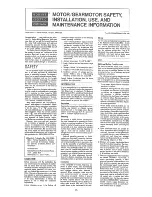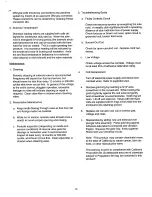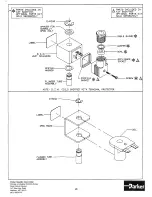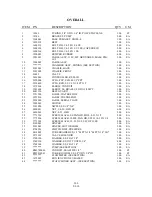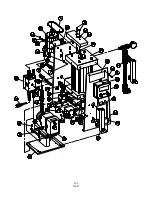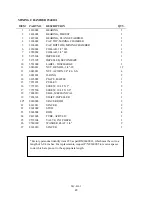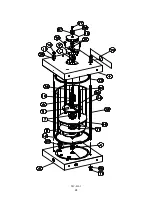
DIAPHRAGM PUMP INFORMATION
WARNING:
ALWAYS wear protective
clothing, face shield, safety glasses and gloves
when working near or performing and
maintenance or replacement on your pump. See
MSDS Sheet from polymer supplier foe
additional precautions.
OUTPUT ADJUSTMENT CONTROLS
In most external controlled pumps the uppermost
knob serves as speed control. Graduations for
the Speed Knob appear directly on the face of the
control panel. The largest knob below is Stroke
Control.
1. Speed adjustment: Speed control provides
adjustment of the percent of maximum strokes
per minute. Turning this clockwise increase
stroke frequency.
Note AA7 Series Only:
When operating pump in the external mode, the
speed control knob should be fully turned counter
clockwise. A click indicates pump is in external
mode.
2. Stroke Adjustment; Stroke control
provides adjustment of percent of maximum
Liquifram (diaphragm) travel. Turning this knob
counterclockwise increases percent output per
stroke. Only adjust while pump is running.
PRIMING THE PUMP
Hold tip of syringe firmly in fitting with one
hand while using the other hand to pull back on
plunger. Repeat until a small amount of polymer
is drawn into the syringe. The pump is now
primed.
PUMP CALIBRATION
Perform calibration if your system application
requires it. Normally calibration is NOT required.
You will need:
- A watch
- A calculator
- Calibrated cylinder (with at least 1000 ml
capacity.
- Length of hose or tubing (same I.D. as
pump ports)
1. Maintain all usual connections to the
PolyBlend unit except disconnect the polymer
suction line at pump input. The flow meter and
pump setting should be those used for normal
service.
2. Connect hose or tubing to the pump input.
Place the free end of the tubing in the graduated
cylinder.
3. Fill the cylinder with polymer to its
measured capacity (for example, 1000 ml etc.).
4. Turn on the metering pump. Allow the
pump to run until all air has been exhausted from
the tubing and pump and polymer is injected into
the mixing chamber.
5. Stop the pump.
6. Refill the cylinder to the measured
capacity.
7. Start the pump again, and start timing as
the pump runs. For best results, let the pump run
long enough to pump at least half of the polymer
out of the graduated cylinder. (in general, the
longer the calibration period, the greater the
accuracy of the measurement).
8. Stop the pump. Record the time and level
of the polymer remaining in the cylinder. Fill in
the following equation to find the volume of
polymer pumped per one unit of time (a minute,
an hour, or a day).
Starting ml - Remaining ml = ml/Time
Calibration period
9. Compare the actual volume pumped to the
desired volume, and adjust pump controls.
10. Check volume again to confirm the new
settings.
11
Summary of Contents for PolyBlend PB200-2
Page 17: ...15 ...
Page 18: ...16 ...
Page 19: ...17 ...
Page 20: ...18 ...
Page 21: ...19 ...
Page 22: ...20 ...
Page 24: ...200 D 007 ...
Page 26: ...MC 0101 24 ...
Page 28: ...Blank Page 26 ...
Page 30: ...OPD 0001 Post Dilution Static Mixer Assembly P N 5860001 28 ...
Page 32: ...Series AA7 Drive Assembly Exploded View Diagram 30 ...
Page 35: ...33 ...
Page 36: ...34 ...

















